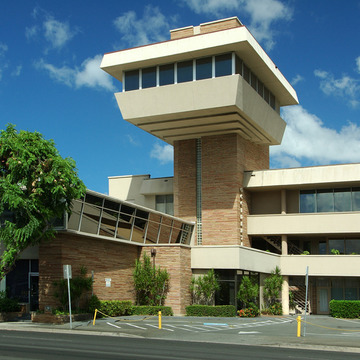This dramatically cantilevered “island in the sky” immediately conveys a jet-age image of modernity. The smooth concrete and glass, 868-square-foot executive office is cantilevered out from a three-story pylon. It adds a gravity-defying tension to the building's already dynamic interplay of horizontal and vertical thrusts. The building's Arizona sandstone veneer, a popular material in Hawaii from the late 1940s through the early 1960s, combines with the horizontality of the two wings to make a sleek, streamlined statement. The building's combination of materials— sandstone walls, smooth concrete lanai railings, cast-stone columns, wrought-iron stair rails, and tile pavers—also typifies the period. This L-shaped structure was originally two stories in height, and the cantilevered office and third story were added in 1967, following the design of Paul Jones. The “eagle nest” was initially the office of Lawrence Takeo Kagawa, who started Occidental Insurance's Hawaii branch in 1933. He built the business into the largest life insurance company in Hawaii, due in part to his convincing the mainland headquarters that the standard actuarial tables indicating Asians were shorter-lived than other people did not apply to Hawaii's population.
You are here
Occidental Life Insurance Company Building
If SAH Archipedia has been useful to you, please consider supporting it.
SAH Archipedia tells the story of the United States through its buildings, landscapes, and cities. This freely available resource empowers the public with authoritative knowledge that deepens their understanding and appreciation of the built environment. But the Society of Architectural Historians, which created SAH Archipedia with University of Virginia Press, needs your support to maintain the high-caliber research, writing, photography, cartography, editing, design, and programming that make SAH Archipedia a trusted online resource available to all who value the history of place, heritage tourism, and learning.















